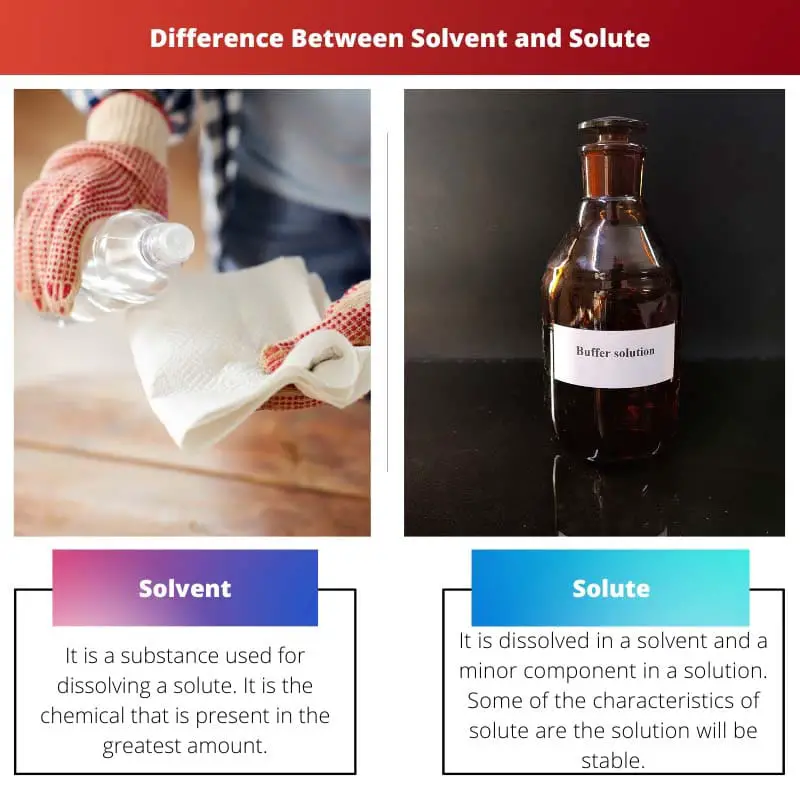To dissolve a solution, the solute is needed. It is because the solute is available in liquid form. In some rare cases, it is available in gaseous form.
A part of a solution is called the solvent. They are available in many types.
The best example to describe solvent and solute is with the help of water. To explain solute more in detail, salt along with water can be used.
Key Takeaways
- Solvents dissolve solutes, creating a solution; solutes are substances dissolved in a solvent.
- Solvents are present in a larger quantity in a solution, whereas solutes are in smaller amounts.
- Solvents can be liquids, solids, or gases, while solutes can be solids, liquids, or gases, depending on the type of solution.
Solvent vs Solute
A solvent is a type of substance which is used as a dissolving medium. The amount of solvent in a solution is greater. There are three major types of solvent. It can also be used in the making of pharmaceutical products. The substance which is dissolved in a solvent is called solute. The amount of solute is less in a solution.

The solvent can dissolve other substances. It is available in liquid form but can also be available in solid form, gas form, or supercritical fluid.
It is a substance in which a solute will be dissolved to form a homogenous mixture. Some of the common examples of solvents are water, methanol, ethanol, and acetone. It will dissolve a given solute and form a solution.
A solute is a substance that is dissolved in a solution. Salt and water are the best examples of solute in our day-to-day life. Salt is dissolved in water.
They together form a saline solution. Therefore, salt is called the solute.
The amount of solvent will be greater than the amount of solute in fluid solutions. The smallest part of the solution is called the solute.
Comparison Table
| Parameters of Comparison | Solvent | Solute |
|---|---|---|
| Boiling point | It is lower than solute. | It is higher than solvent. |
| Used for | It acts as a dissolving medium. | It is a substance that gets dissolved. |
| State | It is mainly found in a liquid state. | It is found in all three states. |
| Solubility | Depends on the solvent properties. | Depends on the solute properties. |
| Transfer of heat | Liquid to the solution. | Solute to a solution. |
What is Solvent?
It is a substance used for dissolving a solute. It is the chemical that is present in the greatest amount. In this substance, each of the remaining chemicals will be dissolved or distributed.
It is divided into three types called oxygenated, halogenated, and hydrocarbon. Some of the uses of solvents are they are used in paints, coatings, cleaning products, and inks.
It is used in personal care products called nail remover and cosmetics.
It has a wide variety of use in healthcare applications called pharmaceutical products. Solvents are basically classified into 2 types called polar and non-polar solvents.
n polar solvent, negative and positive attract the negative and positive charge of the substance they interact with. An example of a polar solvent is water.
The non-polar solvent will have electrons that are distributed all along the molecule. They do not concentrate at the end of the molecule like polar solvents. Benzene is an example of a non-polar solvent.
A basic solvent will accept protons from the solute. In paints, solvents are widely used for dissolving or dispersing various components that are used in paintings and coatings.
This dissolves additional compounds like additives, binders, and pigments. A solvent is good only if it can form hydrogen bonds.
What is Solute?
It is dissolved in a solvent and a minor component in a solution. Some of the characteristics of solute are the solution will be stable. It has only one phase.
A solution is a homogenous mixture with two or more substances. A solution won’t allow beams of light to scatter. Solute in a solution cannot be seen in the naked eye.
The solute is divided into three types called solid, liquid, and gaseous. Solute has colligative properties that depend on the number of particles.
They have no identity. It has low vapor pressure, low freezing point, high boiling point, and high osmotic pressure.
A solute substance has the property that its intermolecular bonds become weaker and weaker when it comes into contact with a solvent and finally dissolves into a solution.
Due to solubility solutions, the amount of solute is limited relative to the amount of solvent. Also, by convention, a solute is rather than a solid rather than a fluid.
This is because when two liquids are mixed, stating that one is miscible with the other, the definition of solubility becomes miscible.
Chemistry as physical science is based on experiments, and few have found that solutes dissolve in large quantities in a given volume of solvent.
It forms a state called supersaturation. A little agitation will immediately initiate precipitation of the solute from such a stage.
Main Differences Between Solvent and Solute
- The boiling point of solvent is lower than solute. On the other hand, the boiling point of solute is higher than solvent.
- The solvent acts as a dissolving medium. On the other hand, the solute is a substance that gets dissolved.
- The solvent is mainly found in a liquid state. On the other hand, the solute is found in all three states.
- The solubility of a solvent depends on the solvent properties. On the other hand, the solubility of a solute depends on its solute properties.
- The transfer of heat is from liquid to solution for solvent. On the other hand, in solute, the transfer of heat is from solute to a solution.




